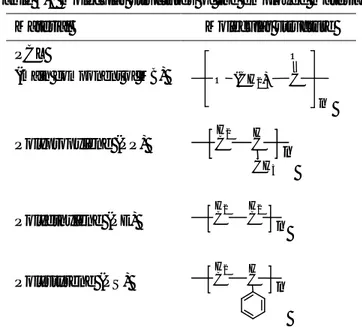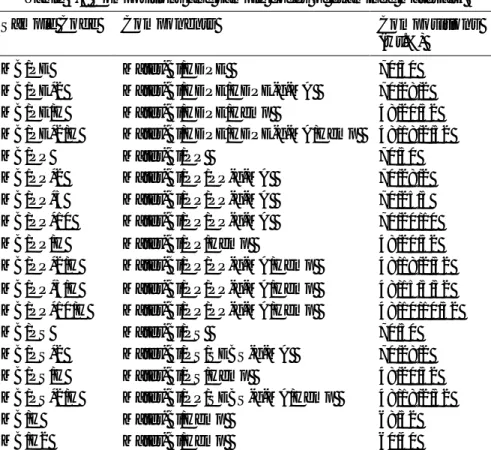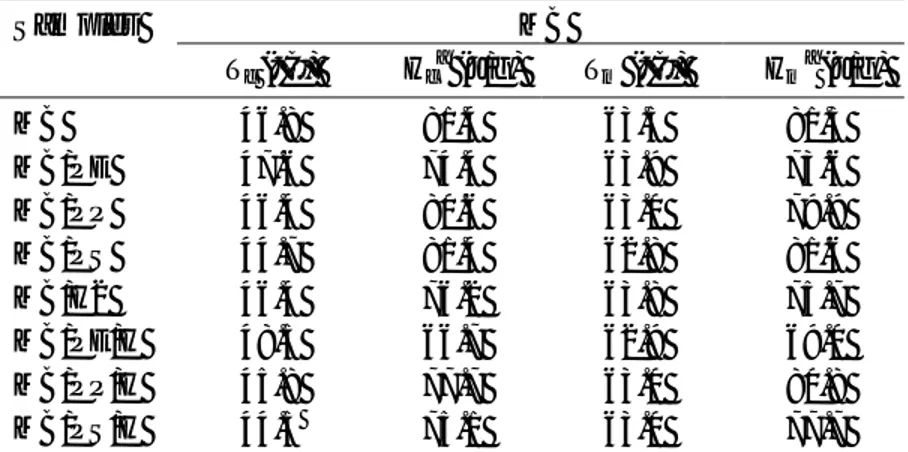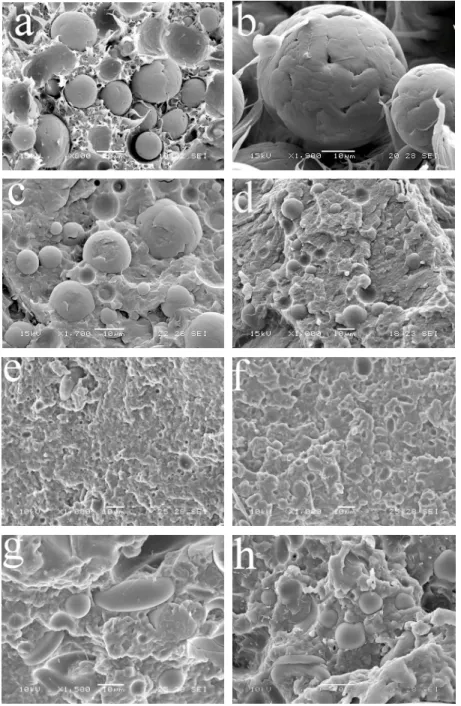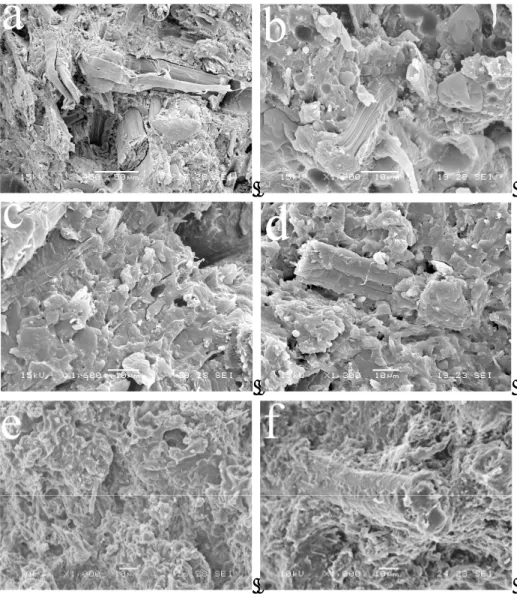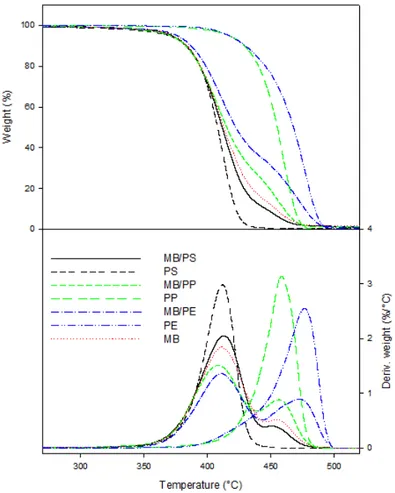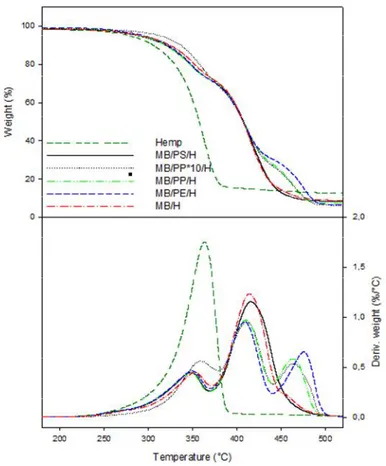TERNARY COMPOSITES OF MATER-BI AND POLYOLEFINS
WITH HEMP FIBRES
4.1 Introduction
The properties of composites based on biodegradable thermoplastics, such as polyesters, polysaccharides, starch and their blends, containing vegetal fibres have been analysed in several papers. Improvements in the tensile behaviour have been reported for composites of various grades of Mater-Bi® - a biodegradable plastic with starch and other components – and cellulosic fibres [166-168]. The growing interest toward the development of novel ecocompatible composites has led to the formulation of systems that include, in addition to intrinsically degradable polymers, also non-biodegradable polymers with additives that can facilitate the processes of environmental degradation. Several polyolefins, such as polyethylene and polystyrene, have been used in mixtures with starch or starch based products (thermoplastic starch/ethylene-vinyl alcohol copolymers, starch + prooxidants) [169], as well as cellulose fibres [170, 171]. It is expected that both the advantageous properties of commodity plastics and the presence of low cost natural fillers provide a good opportunity of reducing the total costs of material while improving the processing and mechanical properties [172].
We prepared and characterized ternary composites of a PCL based biodegradable material, polyolefins and natural fibres that can be used mainly in packaging applications. The presence of the polyolefin component, due to its intrinsic characteristics, was expected to affect crystallization, thermal and mechanical behaviour as well as the processing of the composites. To improve the phase dispersion and the polymer-fibre compatibility, various polymers and copolymers modified with reactive groups – able to give rise to specific interactions at the interface between the components- were used.
4.2 Experimental
4.2.1. Materials
A biodegradable and compostable thermoplastic, MaterBi-Z (MB), based on poly(ε-caprolactone), thermoplastic starch and additives (biodegradation time under controlled conditions: 20-45 days), was kindly supplied by Novamont (Novara, Italy). Polypropylene (PP) Moplen X30S (MFR= 8-10 g/10 min, Mw= 350,000 and Mn= 46,900), and polypropylene-graft-maleic anhydride (PP-g-MA) (MA content 0.5-1% wt.%) were supplied by Himont and Montell, Italy, respectively. High density polyethylene (HDPE), Eltex B5920 (MFR= 0.39 g/10 min) was supplied by Solvay. Polystyrene (PS) powder (density=1.05 g/cm3) was supplied by Goodfellow, England. HDPE-g-MA, Polybond 3009 (MFR= 3-6g/10 min, density= 0.95 g/cm3, MA content 4 wt.%) was supplied by Uniroyal Chemical, Italy. SEBS-g-MA, Kraton FG-1901X (MFR=22 g/10 min (200° C, 5 Kg), density=0.91 g/cm3, MA content 2 wt.%) was supplied by Shell Chem, Italy.
Hemp (cannabis sativa) fibres were kindly supplied by Sassetti Agricoltura S.r.l. (Bientina, Italy). In order to remove the non-cellulosic components, the fibres were first washed with liquid soap and immersed in 6% NaOH solution for 24 hours at 40°C. The alkali treatment increases the number of free hydroxyl groups on the fibre surface and produces changes in the chemical composition by extracting lignin and hemicellulose [2]. After NaOH treatment the fibres were repeatedly rinsed with distilled water, dried at 105°C and finally stored for use. List of the employed materials with their molecular structure are reported in Table 4.1.
Table 4.1 Molecular structures of the employed materials Material Molecular structure PCL (main component of MB) O (CH2)5 C O n Polypropylene (PP) H2 C HC n CH3 Polyethylene (PE) H2 C H2 C n Polystyrene (PS) H2 C HC n 4.2.2. Processing of composites
Blends of MB with PP, HDPE and PS (MB/PP, MB/PE, MB/PS) and their composites with hemp (MB/PP/H, MB/PE/H, MB/PS/H) were prepared in a Brabender Plasti-corder internal mixer at a temperature of 175 °C (Fig. 4.1). The mixing was carried out under nitrogen flux for 7 min using a rotor speed of 60 rpm. To increase the compatibility of the components in the various systems PP-g-MA, HDPE-g-MA and SEBS-g-MA copolymers were added (2 wt.%) to the respective blends and composites.
The composites were prepared by using a two-step mixing procedure: in the first step, masterbatches of MB and hemp (60/40 w/w) were processed in Brabender, then in the second step, 80 wt% of masterbatch was melt mixed with 20 wt% of polyolefin under the same conditions. In order to analyze the effect of compatibilizer amount on the morphology and final properties of blend and composite, various amounts of PP-g-MA (2–10 wt.%) were added to MB/PP matrices. All the examined systems are enlisted with their code in Table 4.2.
Fig. 4.1 - Flow diagram for proccessing of blends and composites.
Table 4.2 Compositions and sample codes of examined materials.
Sample Code Components Compositions
(wt.%) MB/PE Mater-Bi/HDPE 70/30 MB/PE*2 Mater-Bi/HDPE/HDPE-g-MA 70/28/2 MB/PE/H Mater-Bi/HDPE/Hemp 48/20/32 MB/PE*2/H Mater-Bi/HDPE/HDPE-g-MA/Hemp 48/18/2/32 MB/PP Mater-Bi/PP 70/30 MB/PP*2 Mater-Bi/PP/PP-g-MA 70/28/2 MB/PP*5 Mater-Bi/PP/PP-g-MA 70/25/5 MB/PP*10 Mater-Bi/PP/PP-g-MA 70/20/10 MB/PP/H Mater-Bi/PP/Hemp 48/20/32 MB/PP*2/H Mater-Bi/PP/PP-g-MA/Hemp 48/18/2/32 MB/PP*5/H Mater-Bi/PP/PP-g-MA/Hemp 48/15/5/32 MB/PP*10/H Mater-Bi/PP/PP-g-MA/Hemp 48/10/10/32 MB/PS Mater-Bi/PS 70/30 MB/PS*2 Mater-Bi/PS/SEBS-g-MA 70/28/2 MB/PS/H Mater-Bi/PS/Hemp 48/20/32 MB/PS*2/H Mater-Bi/PP/SEBS-g-MA/Hemp 48/18/2/32 MB/H Mater-Bi/Hemp 68/32 MB/H2 Mater-Bi/Hemp 60/40
4.3 Results and discussion
4.3.1. Thermal behaviour Temperature (°C) 40 60 80 100 120 140 160 N o rm a liz e d h e a t fl o w e n d o u p MB MB/PE MB/PE/H MB/PP MB/PP/H MB/PS MB/PS/H PE PPFig. 4.2 - DSC cooling thermograms of MB and its blends and composites with PP, PE, PS and hemp (cooling rate: 10°C/min).
Fig. 4.2 shows the DSC cooling thermograms of MB, blends of MB with polyolefins and ternary composites of MB, polyolefins and hemp (without compatibilizer). The values of phase transition temperatures (Tc: crystallization peak temperature, Tm:
melting peak temperature) and enthalpies (Hc: crystallization peak area, Hm:
melting peak area) recorded by DSC on 2nd heating run are summarized in Table 4.3. The degree of crystallinity of the crystallizable polymer components was calculated by the equation (4.1):
Xc(%)= (Hm/W H°m) 100 (4.1)
where Hm is the experimental heat of fusion, W is the matrix weight fraction and
Hm 0
is the heat of fusion of 100 % crystalline polymer, with ∆H°m (HDPE) = 293 J/g
and ∆H°m (PP) = 165 J/g [173]. As shown in Table 4.3, incorporation of a polyolefin
into the biodegradable material produced only minor changes in the crystallization and melting behaviour of MB, as a consequence of phase separation phenomena due to the lack of miscibility between the polyolefin and other polar components (i.e., polyester and starch), even if the existence of crystalline interactions have been reported for blends of PCL with polyethylene and polypropylene [174]. The data in Table 4.3 indicate that, on cooling from the melt, the crystallization temperatures (and enthalpies) of MB/polyolefin blends did not display significant variations. According to the phase separation phenomena, the crystallinity degree of PE and PP in the blends remained almost unchanged with respect to plain polymers. Investigations by polarized optical microscopy on MB/PP films cooled
Fig. 4.3 - Polarized optical micrographs of MB/PP 70/30 film during crystallization on cooling from the melt at 10 °C/min: (a) T= 115 °C (crystallized PP phase), (b). T= 50 °C (starting of MB crystallization) and (c) T= 40 °C (complete crystallization of PP and MB phases).
c
100 μma
100 μmfrom melt at 10 °C/min, showed that the growth of phase separated PP spherulites took place near to 120 °C, then the crystallization of MB matrix was initiated at about 50 °C at the boundary surface of PP spherulites and rapidly completed over all the mass of MB phase (Fig. 4.3). On subsequent heating (10 °C/min) the melting of the two polymer phases took place at the usual temperatures of pure polymers. Further, DSC data indicated that the presence of fibres in MB/H blends did not have nucleating effect on the crystallization behaviour of the MB matrix. In the case of ternary systems a different thermal behaviour was recorded for MB/PE/H and MB/PP/H, that can be related to the differences observed in phase morphology. An increase of Tc of both polymer components was noticed
Table 4.3a Thermal characteristics of MB in blends and composites. MB Samples Tc (°C) ∆Hc a (J/g) Tm (°C) ∆Hm a (J/g) MB 46.8 81.4 63.5 81.3 MB/PE 47.6 74.4 63.9 73.6 MB/PP 46.4 80.6 63.0 79.9 MB/PS 44.7 81.4 62.8 81.6 MB/H2 46.4 76.2 63.8 75.7 MB/PE/H 48.5 66.7 62.9 69.0 MB/PP/H 45.8 77.7 63.0 80.8 MB/PS/H 44.5 75.1 63.0 77.7
Table 4.3b Thermal characteristics of PE in blends and composites. PE Samples Tc (°C) ∆Hc a (J/g) Tm (°C) ∆Hm a (J/g) Xc (%) PE 115.6 152.7 129.7 151.3 52 MB/PE 116.3 161.7 129.2 163 52 MB/PE/H 118.0 154.5 131.0 156.2 53
Table 4.3c Thermal characteristics of PP in blends and composites. PP Samples Tc (°C) ∆Hc a (J/g) Tm (°C) ∆Hm a (J/g) Xc (%) PP 110.8 94.6 162.8 94.1 57 MB/PP 115.6 89.5 160.2 88.0 53 MB/PP/H 111.7 87.5 159.7 85.6 52 a
The values of heat of crystallization and heat of fusion were calculated per gram of polymer component.
Temperature (°C) 40 60 80 100 120 140 160 N o rm a liz e d h e a t fl o w e n d o u p MB PP MB/PP MB/PP*2 MB/PP*5 MB/PP*10 46.5 °C 125 °C 110.8 °C
Fig. 4.4a - DSC cooling thermograms of MB, PP and MB/PP blends compatibilized with various PP-g-MA amounts (cooling rate: 10 °C/min). Temperature (°C) 40 60 80 100 120 140 160 N o rm a liz e d h e a t fl o w e n d o u p 110.8 °C 47.4 °C 119 °C MB PP MB/PP/H MB/PP*2/H MB/PP*5/H MB/PP*10/H
Fig. 4.4b - DSC cooling thermograms of MB, PP and their composites compatibilized with various PP-g-MA amounts (cooling rate: 10 °C/min).
for MB/PE/H sample, accompanied by a significant decrease of the heat of crystallization of MB phase as compared to plain MB. These changes could be accounted for by the effect of highly dispersed polyolefin phase and the presence of fibres on the crystallization of MB matrix. For MB/PP/H sample no nucleating effect of hemp on PP crystallization was evidenced, unlike that reported for the crystallization process of binary PP/hemp composites where the presence of fibres
resulted in a neat increase of Tc andcrystallinity of PP matrix [73]. However, it is
expected that in ternary composites the interfacial interactions between polyolefin and fibres are limited owing to the dispersion of the polyolefin phase and fibres within the MB matrix (following the two-step mixing procedure). For MB/PS and MB/PS/H systems a little decrease of Tc of MB was found.
In the presence of compatibilizer different crystallization behaviour was observed. Fig. 4.4 shows the effect of PP-g-MA content on the crystallization behaviour of MB/PP blends and MB/PP/H composites respectively, analysed by DSC on cooling from melt at 10 °C/min. In all cases the crystallization peak temperature of PP increases with the compatibilizer content: for a PP-g-MA amount of 5 wt.%, Tc of
PP increased from 110.8 °C (pure PP) to 125 °C in MB/PP*2 blends and to 120 °C in MB/PP*2/H samples respectively. The changes in the crystallization behaviour can be ascribed to nucleating effects induced by the presence of PP-g-MA copolymer. DSC analysis also indicated that for all examined composites both crystallization and melting temperatures of MB matrix were not influenced by the type and content of compatibilizer.
4.3.2. Morphology
SEM micrographs of fracture surfaces of the examined blends (with and without compatibilizer) are presented in Fig. 4.5. For all samples, MB matrix and dispersed polyolefin phase appear as separated phases, due to the immiscibility of components. Blends MB/PP exhibited a characteristic droplet-like morphology with rather homogeneous size distribution (Fig 4.5a), and a similar morphology was observed for MB/PE (Fig. 4.5e), whereas MB/PS blends displayed a large size distribution of the dispersed phase with irregular shape resembling a co-continuous morphology (Fig. 4.5g). The micrographs of compatibilized systems indicated an improved phase dispersion and interfacial adhesion between polyolefins and MB. Generally, the number average size of PP dispersed particles is larger than that of PE particles, even if the two blends displayed a different size distribution. For MB/PP blends, it was found a remarkable effect of PP-g-MA content on the average particle size, which decreased from a value of about 28 m for the uncompatibilized sample (Fig. 4.5a, b) to about 9 m for the sample with 10 wt% of compatibilizer (Fig. 4.5d); however, it must be noticed that the addition of 2 wt.% of compatibilizer caused a significant size reduction of PP particles to a value near 12 m (Fig. 4.5c). For MB/PE blends the average size of dispersed phase was around 5 m, without any significant variation upon addition of 2 wt% of HDPE-g-MA (Fig. 4.5f).
Fig. 4.6 shows the SEM micrographs of fracture surfaces of composites with hemp. MB/H2 sample generally showed weak interactions between matrix and fibres and at higher fibre content (40 wt.%) the fibre dispersion became worse (Fig. 4.6a). On the other hand, for ternary composites the dispersion of fibres and polyolefin in the matrix appeared almost uniform. The addition of compatibilizer contributed to reduce the particle size of dispersed polyolefin and improve the adhesion between fibre and matrix (Fig. 4.6c-f), as a consequence of interactions between the anhydride groups and hydroxyl groups of polysaccharide chains (i.e, starch and
cellulose). The occurrence of such interactions has been reported for several polyolefin composites compatibilized with maleated PP [175-177].
Fig. 4.5 - SEM micrographs of (a) MB/PP, (b) PP particle (showing the growth of spherulites) in MB/PP blend, (c) MB/PP*2, (d) MB/PP*10, (e) MB/PE, (f) MB/PE*2, (g) MB/PS, (h) MB/PS*2 blends.
Fig. 4.6 - SEM micrographs of (a) MB/H2, (b) MB/PP/H, (c) MB/PP*2/H (2 wt% PP-g-MA), (d) MB/PP*10/H (10 wt% PP-g-MA), (e) MB/PE*2/H (2 wt% HDPE-g-MA), (f) MB/PS*2/H (2 wt% SEBS-g-MA) composites.
4.3.3. Thermogravimetric analysis
Exemplary TG and DTG thermograms of MB, blends and composites with hemp, at a heating rate of 10 °C/min, are shown in Fig. 4.7. The DTG curve (i.e., the temperature dependence of the degradation rate) of plain MB in nitrogen displayed a large peak in the region 300-450 °C with maximum at 410 °C - which is to be ascribed to degradation of PCL (the major component of MB) while the starch degradation is at about 320 °C - followed by a minor peak near to 460 °C, which can be ascribed to the presence of additives (Fig. 4.7a); for plain polyolefins the
maximum degradation rate was recorded at about 411 °C for PS [178], 458 °C for PP [179] and 477 °C for HDPE [169] respectively (Fig. 4.7a). DTG curves of blends generally show a main peak above 400 °C characteristic of the MB matrix (PCL component) accompanied by peaks at higher temperature (Fig. 4.7a): for MB/PS the peak of PS coincides with that of PCL at 410 °C (the lower peak at about 460 °C is due to MB), while for MB/PE the peak at 472 °C corresponds to the degradation of the polyolefin. For MB/PP the peak at about 450 °C is due to the overlap of the peak of PP with the high temperature peak of MB. DTG thermograms carried out at 5 °C/min display very similar degradation behaviour but with maxima shifted to lower temperature.
Fig. 4.7a - TGA and DTG curves of (a) MB, PP and their blends as a function of temperature.
Fig. 4.7b - TGA and DTG curves of ternary composites as a function of temperature.
As shown in Fig. 4.7b the degradation peak of hemp fibres was centered at 363 °C. The thermal degradation of hemp is mostly a two-stage process, the first at temperatures in the range 220-315 °C is generally associated with degradation of hemicellulose (270 °C) and the second at higher temperatures, in the range 315-400 °C, is ascribed to degradation of cellulose (360 °C) [127]. The DTG curves of ternary composites containing hemp fibres generally display three main peaks corresponding to the degradation of hemp (350-363 °C), PCL (408-415 °C) and polyolefin (415-475 °C) respectively (Fig. 4.7b).
The composite containing PS displayed a double peak with a pronounced maximum at 415 °C as a result of overlap of polyester and polyolefin peaks (with maximum at higher temperature respect to MB/PS blend). The degradation behaviour of the fibres in the composites appears to be influenced by the polyolefin type, likely owing to differences in the morphological features and crystallinity of these systems; in ternary composites temperature corresponding to the maximum weight loss rate of the fibres was decreased (348 °C) as compared to the compatibilized systems (360 °C). In particular, for the compatibilized MB/PP*10/H
sample a decrease of the degradation rate was observed in the range 230-350 °C, that can be accounted for by a higher polymer/fibre interfacial adhesion due to the interactions between the functional groups of PP-g-MA and hemp [73, 180].In the DTG curves of composites and blends the peaks of PP and PE are shifted to lower temperature with respect to plain polyolefins, suggesting a lower thermal stability of the polyolefins when they are dispersed within the biodegradable matrix. Similar effects, which can be associated with lower values of the activation energies for the degradation of polyolefin (and starch) have been reported for composites of HDPE and LDPE with MB [169].
4.3.4. Mechanical tests
Typical curves of mechanical tests for MB/polyolefin blends and their composites with hemp are summarized in Fig. 4.8. The tensile parameters recorded for blends and composites, without and with addition of compatibilizer, are reported in the bar diagrams of Fig. 4.9.
Table 4.4 Tensile mechanical properties of MB/PP blends and MB/PP/H composites. Samples Modulus (MPa) Strength (MPa) Elongation at break (%) MB 43338 17.20.8 7.8±2.0 MB/PE 48424 7.80.2 2.7±0.2 MB/PE*2 47523 7.30.3 2.5±0.2 MB/PP 64170 10.51.2 3.2±0.6 MB/PP*2 71334 10.31.1 2.2±0.3 MB/PP*5 64347 11.21.8 2.1±0.2 MB/PP*10 67041 15.50.5 3.2±0.3 MB/PS 75126 14.51.4 3.1±0.3 MB/PS*2 71741 13.32.0 3.0±0.5 MB/H 1273±71 30.4±1.7 5.2±0.7 MB/H2 140671 15.20.8 2.3±0.3 MB/PE/H 156874 32.02.0 4.90.5 MB/PE*2/H 1389368 29.67.3 5.21.1 MB/PP/H 136045 22.13.2 2.90.7 MB/PP*2/H 115070 20.22.5 2.70.2 MB/PP*5/H 160030 22.31.0 2.5±0.3 MB/PP*10/H 138040 20.23.0 2.4±0.2 MB/PS/H 158272 32.81.5 4.00.6 MB/PS*2/H 147481 26.53.1 2.90.2
The tensile properties of MB are essentially unaffected by changes of the temperature used in the melt processing of the material (100 or 175 °C). The blends show higher values of modulus and lower strength with respect to plain MB (Fig. 4.9a). In particular, the strength of MB/PS results to be higher than that of MB/PP and MB/PE. The incorporation of 32 wt.% of fibres into MB (MB/H) caused a marked rise of the modulus from 440 to about 1300 MPa – with an increase higher than 200% - and of tensile strength from about 16 to 30 MPa.
0,00 0,02 0,04 0,06 0 10 20 30 40 MB/PE ( M P a ) Strain (mm/mm) MB MB/PS MB/PP
Fig. 4.8a - Stress-strain curves of tensile tests for blends of MB with polyolefins. 0,00 0,02 0,04 0,06 0 10 20 30 40 MB/H2 (MPa ) Strain (mm/mm) MB/H MB/PS/H MB/PP/H MB/PE/H
Fig. 4.8b - Stress-strain curves of tensile tests for MB/H and ternary composites.
0 500 1000 1500 2000 MB MB/PE MB/PE*2 MB/PP MB/PP*2 MB/PS MB/PS*2 Material T e n s il e m o d u lu s ( M P a ) 0 20 40 60 80 100 T e n s il e s tr e n g th ( M P a ) Tensile modulus Tensile strength
Fig. 4.9a - Bar diagram of tensile modulus and strength for MB and blends. 0 500 1000 1500 2000 MB MB/H2 MB/H MB/PE/H MB/PP/H MB/PS/H T e n s ile m o d u lu s ( M P a ) 0 20 40 60 80 100 T e n s ile s tr e n g th ( M P a ) Tensile modulus Tensile strength
Fig. 4.9b - Bar diagram of tensile modulus and strength for MB/H and composites.
Increasing the fibre content to 40 wt.% (MB/H2), the modulus was further increased while the strength was reduced (Fig. 4.9b), likely due to the effect of dispersion of the fibres inside the matrix. A similar improvement of tensile properties has been described for composites of Mater-Bi Z® with flax cellulose pulp in the composition range 0-40 wt.% of fibres [167]. In blends, the tensile modulus increased when MB was mixed with PP and PS, whereas no significant improvements were observed on mixing with HDPE; on the opposite, the values of strength were reduced for all blends as compared to MB alone (Fig. 4.9a). The addition of compatibilizers (2 wt.%) did not induce significant changes on the tensile properties; however, for MB/PP samples with increasing the compatibilizer content (5-10 wt.%) - as shown in Table 4.4 -, an improvement of strength was observed suggesting the occurrence of effective interactions between the components, in accordance with the results of DSC and SEM analyses. The ternary composites generally display higher properties than those of MB and blends (Fig. 4.9b). Tensile modulus was
also improved with respect to MB/H and the strength, for systems with PE and PS, increased above 32 MPa. The addition of compatibilizer did not show significant effects on the tensile behaviour of the composites; for MB/PP/H the values of modulus and tensile strength underwent little changes with increasing the PP-g-MA amount.
4.3.5. Rheological behaviour
The melt viscosity behaviour of MB/polyolefin blends and their composites with hemp is shown in Fig. 4.10. The melt rheology curves were fitted to the power law expression [138]:
= ARh (n
Rh) (4.2)
where η is the apparent viscosity, ARh a preexponential factor, ω the oscillation
frequency of the rheometer equivalent to shear rate and nRh the shear thinning
exponent. The values of rheological parameters - such as G', G'' and - of blends and composites, recorded at a frequency of 1 Hz, are listed in Table 4.5.
Table 4.5 Rheological parameters of blends and composites at frequency =1 s-1.
Samples G'(Pa) G'' (Pa) (Pa.s)
MB/PE/H 20900 28700 27000 MB/PE*2/H 15900 37200 34900 MB/PP/H 23300 25700 24200 MB/PP*2/H 30600 37300 35000 MB/PS/H 57900 103000 96700 MB/PS*2/H 37100 80300 75400
It is possible to notice that the melt viscosity and moduli (G’, G’’) of HDPE based blend was generally higher than that of PP and PS based ones. On addition of compatibilizer (2 wt.%) an opposite behavior was found: melt viscosity decreased in the presence of HDPE-g-MA for MB/PE (Fig. 4.10a), but increased with addition of PP-g-MA for MB/PP blends (Fig. 4.10b). This effect could be associated with the viscosity range of each polyolefin component, as well as with changes of the morphology (and size) of dispersed phases due to the interchain interactions promoted by the functional groups. For the composites, the viscosity values were markedly higher than that of blends, which is an expected behavior to be related with the incorporation of fibres [181]. This trend was affected by the type of polyolefin, the highest values being observed for composites with PS (Table 4.5). Similar tendencies were observed for the other rheological parameters, i.e. storage and loss shear modulus (G' and G''), as reported in Table 4.5. In general, it appears that the addition of compatibilizer does not affect the viscosity of the composites in the low shear range, whereas significant differences are observed at
high shear rates (especially for composites with PE), most likely as a consequence of lower viscosity values.
0,1 1 10 100 1000 10 100 1000 10000 100000 MB/PE MB/PE*2 MB/PE/H MB/PE*2/H V is c o s it y ( P a .s ) s-1)
Fig. 4.10a - Melt viscosity of MB/PE and MB/PE/H as a function of shear rate. 0,1 1 10 100 1000 10 100 1000 10000 100000 MB/PP MB/PP*2 MB/PP/H MB/PP*2/H V is c o s it y ( P a .s ) s-1)
Fig. 4.10b - Melt viscosity of MB/PP and MB/PP/H as a function of shear rate.
4.4 Conclusion
Binary and ternary systems based on a biodegradable polyester matrix (MB) with polyolefins (PP, PE and PS) and hemp fibres as dispersed components were characterized by microscopic, thermal, mechanical and rheological analyses.
Reactive compatibilizers (PP-g-MA; HDPE-g-MA and SEBS-g-MA, respectively) were added in order to improve the interfacial interactions between the polymers and fibres. It was found that the incorporation of a polyolefin in the biodegradable matrix influenced the crystallization behaviour of the components. Nucleating effects on MB crystallization were observed at the interface of polyolefin particles in MB/PP blends. SEM and DSC analyses revealed changes of morphology and phase transition temperatures both for blends and composites in the presence of compatibilizers. The addition of PP-g-MA (2-10 wt%) in MB/PP and MB/PP/H systems resulted in an improved phase dispersion with reduced particle size and better interfacial adhesion.
The thermogravimetric analysis showed that the maximum weight loss rate of PP and PE in the composites is shifted to lower temperature with respect to plain polyolefins, suggesting a lower thermal stability of the polyolefins dispersed within the biodegradable matrix. On the other hand, the degradation rate of the fibres in the composites appeared to be reduced by the presence of compatibilizer, likely due to the effect of chemical interactions between the functional groups at the interface.
Regarding the mechanical properties, tensile modulus increased when MB was mixed with polyolefins, while the strength was reduced; the addition of compatibilizers (2 wt.%) resulted in no significant changes of tensile parameters. An increase of strength was observed for MB/PP blends at higher PP-g-MA content. In the case of composites, modulus and tensile strength generally increased with polyolefin and fibres incorporation, the largest values being reached for composites with PE and PS.
It can be concluded that the results reported here for the ternary systems support the expectations expressed in the introduction: namely the introduction of the polyolefin component in the biodegradable (polyester) matrix, as compared to the binary matrix/fibre system, may have some significant advantages in terms of properties and processability, as well as cost. Indeed, morphological analysis showed that it is possible to obtain a sufficiently homogeneous dispersion of the polyolefin phase - especially in the case of PE and PP composites - along with the fibres (30 wt%) by controlling the particle size (and interfacial adhesion) through the introduction of a compatibilizer (modified polyolefin). Moreover, the addition of polyolefin may have a positive effect on the processability (higher thermal stability of the ternary composites compared to MB/H). From the mechanical point of view, for ternary composites the tensile tests showed values of modulus and stress better than those observed for the MB/H batch product. An increase of the fraction of fibres in the composite (> 30 wt%) generally leads to a worsening of the processability in the melt (mixing, extrusion, etc.). and especially of the mechanical properties (low ductility and impact resistance, low stability, etc.); otherwise, the addition of the polyolefin component in low concentration (10-20 wt%) - compared with an equivalent amount of fibre (as for the batch product MB/H2) - seems to lead to a positive balance of properties, and also of cost considering the overall reduction that can be obtained in the amount of matrix employed (≤ 50 % by weight).
